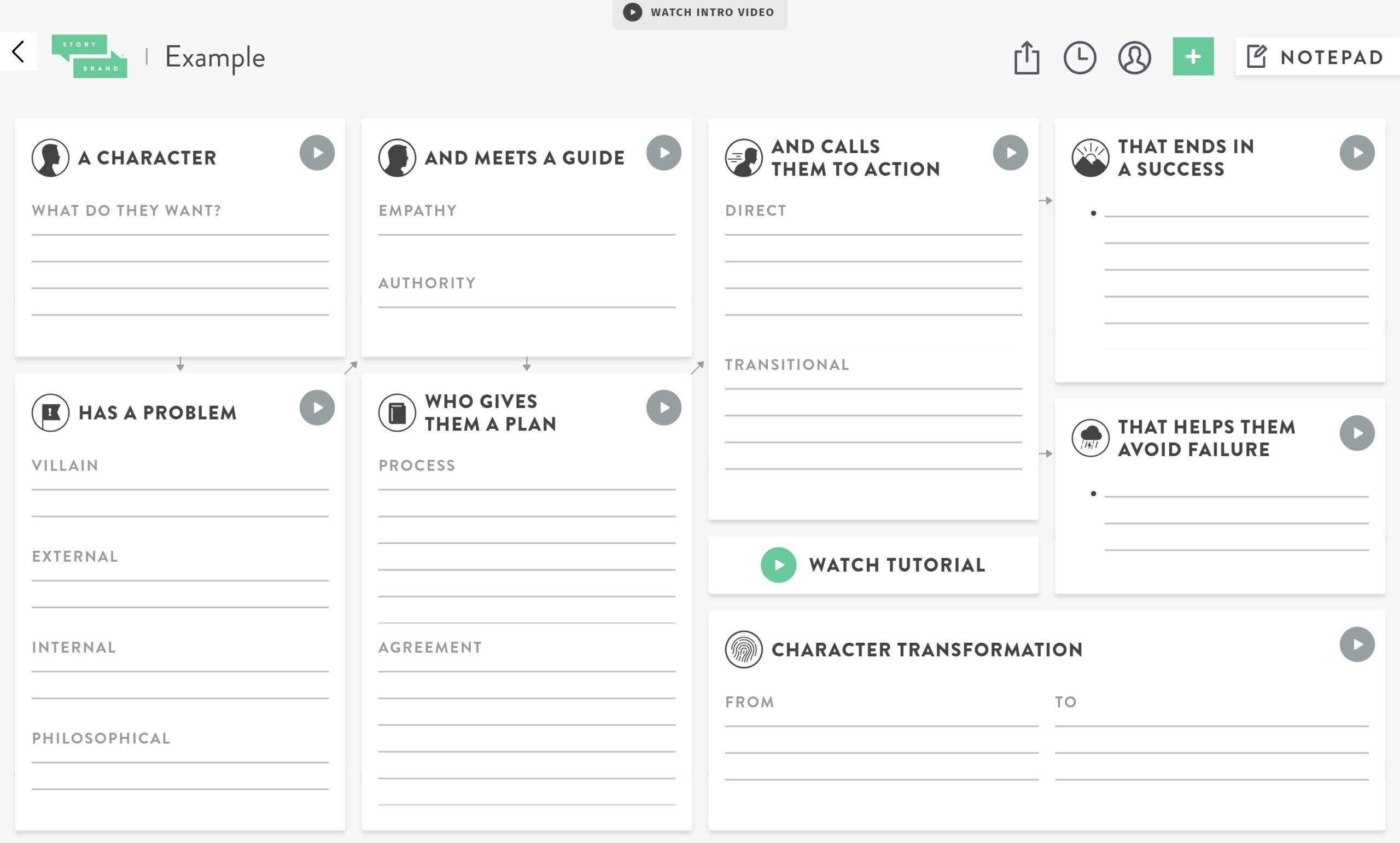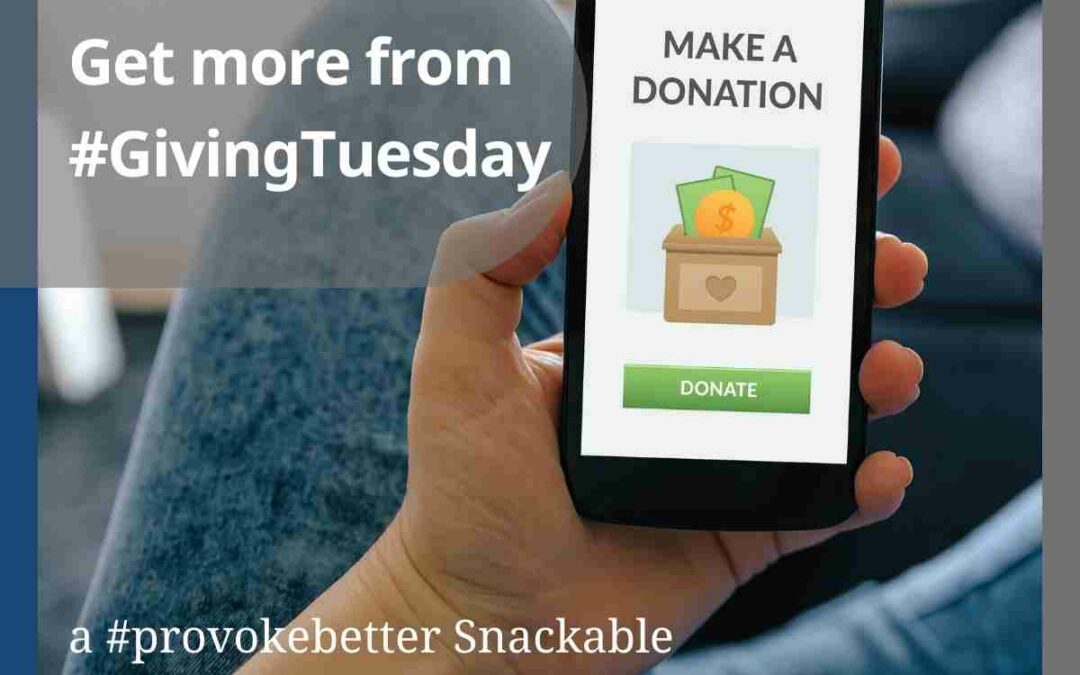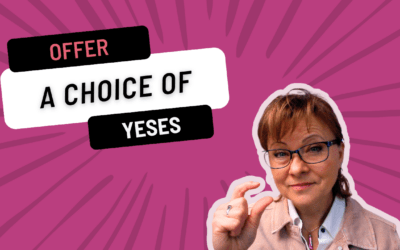Nonprofits can boost donations with better marketing messages.
This is the fourth installment of our Snackable Series Live on Marketing Messages. The text below is adapted from our Live conversation.
My goal is to help nonprofits make Giving Tuesday just a little bit more giving – a little bit bigger and better.
Giving Tuesday is about 10 years old. It’s a relatively new “holiday”. But it’s a way to help remind us that generosity is great to practice, particularly near the end of the year. Nonprofits are trying to make sure that they have exactly what they need to continue with their great programs, and we’re looking for a tax donation. So it’s a win-win situation.
The problem is that many nonprofits don’t really have a lot of creativity behind their Giving Tuesday messages. It’s kind of bland, vanilla stuff like: “Hey, it’s Giving Tuesday. Don’t you want to support us?”
They really haven’t done a good job of connecting us with the mission, or connecting us, as potential donors, with what’s in it for us.
Even as we give money, there’s a reason we’re giving it. There’s something that’s connecting us to this giving. And it’s the nonprofit’s responsibility to help draw that out.
On today’s Snackable, I give you a few tips on how to do that.
The Resource You Need To Craft The Perfect Message
Use my favorite free resource to craft your marketing message: mystorybrand.com. They’ll ask you to set up a free account and a couple of demographic questions, and then you get this online, digital BrandScript: :

Now, you know, I’m a big fan of story. I’ve used storytelling elements for over 15 years producing great videos, including some fundraising videos that helped nonprofits get thousands and thousands of dollars in extra donations.
And the structure of StoryBrand that I use for videos is the same structure that you can use to create social media messages, email campaign messages, special end of the year asks, and everything related to the Giving Tuesday campaign material that you want to develop.
So go to mystorybrand.com and get that free account. Once you’re on the platform, you can go to each one of the story module sections, which also gives you some prompts on how to build your story, starting with the character.
Now, the very first thing you need to understand for writing a message for your nonprofit is that you actually have two different types of message structures.
You don’t want to mix them and match them in any particular message, but you could find a way to use them both. So let’s take a look at what each of those are.
First Type of Structure: Mission-Based Script
Every nonprofit needs to create a mission-based script. And again, by script I mean those seven story elements that we just saw in the StoryBrand framework.
This script is what talks about the recipients of your services as the heroes have their own stories.
This could be the African mom who is trying to get clean water for her family. This could be the local farmer who is trying to connect his and her produce with the local consumers. This could be an environmental agency that wants to make sure that we have pollinators around forever.
I like all of those things, right?
So, in creating a mission-based script, you put the people that you serve, or the animals, or whatever it is, at the center of the story. They are the characters, if you will. What StoryBrand calls the “hero” of the story.
And we want to see the rest of that story supporting the character. Supporting in this case, the recipient of your services.
Case studies and testimonials are great to use here.
You can talk about how someone’s life was like before they had access to clean water, for example. And then what your organization did to help them get clean water safely, and then what their life is like after.
Showing that transformation is such a compelling storytelling technique. You can use it for Giving Tuesday, and in every single campaign message. Show the before, how does your organization help, and what their life is like after.
This is how you connect a potential donor, whether it’s of my time, my treasure, or my talents to your organization.
Mission-based script is the one that every nonprofit needs to have. There’s a second type that you optionally can add as well. And that’s the donor-based script.
Second Type of Structure: Donor-Based Script
This script puts the donor as the hero, and it can be effective as well.
By contributing to the organization, donors are fulfilling a need to. We want to enlarge our legacy, we want to build a better world, we want to increase justice.
There are reasons that we feel like we want to connect ourselves with the success that your organization is helping to bring about. That’s what a donor-based script does.
So now that I’ve given you the quick reviews, let’s look at those script components again, for just a moment.
The Components of Your Script
Remember, in the mission-based script, the one script that everyone must have, you want to put the recipient of your service right in the character, they’re the hero. They’re the ones going through the adventure.
The pre transformational adventure, it’s always rough, right? Then what’s the problem? The problem could be: “I don’t have access to clean water. It’s unsafe for me to trek five miles through the African jungle to try to get clean water. And it puts myself and my family at risk when I don’t have it.”
Those are problem statements. If you’re working for the environment, you could be trying to make sure that pollinators are here to help our plants stay healthy.
In this example, what’s the problem? Well, the bee is having a hard time. And why is that? Well, because pollution is up because pesticide use is also up because access to the types of wildflowers that are typically native to the area are down, these are all problems.
Your organization then comes in as the guide, that’s our third piece here. And the guide is the person, or in this case, the organization that is credible and empathetic.
They’re in the position to solve this problem and the donor is helping. So the donor almost becomes a sidekick, if you will, with the organization and together, you guys are helping resolve this issue that your main character has, that the recipient of your program is facing.
And that’s exactly why you’re in business in the first place, right?
In a Giving Tuesday campaign, it can be kind of tricky to talk about all seven elements present on the Brand Script model we’re discussing.
These three are the most important and critical:
- Understanding the character, the recipient of your program.
- Understanding what their problems are.
- Understanding what a potential donor needs to do to resolve those problems.
Always Remember to Include a Call To Action
Now, this may seem obvious to you, but you would be surprised at how many campaigns I review where the call to action is a little weak, soft, confusing, and sometimes not even there.
The call to action is the thing that triggers people to respond. It’s the piece of communication that tells them what to do next.
It may be as simple as a “Donate Now” button. It may be: “Volunteer Now”. Or maybe: “Take the pollinator safety pledge”, where the person vows to plant five native flowering plants in their garden for Spring.
The point is that whatever it is, you need to be as specific, clear, and concise as possible, because you don’t want people being confused, burning extra calories, and trying to figure out what it is you want from them.
So make it very easy for them to go there.
Podcast Resources for NonProfits
If you want more resources from StoryBrand for nonprofit marketing messaging, they just released a couple of podcast episodes on the subject.
1. The first one is the one that talks about the mission-based script and the donor-based script in more detail than I have time to share with you today.
2. And then, part two talks about the four different types of nonprofit work. The goal is to help you understand if you’re in the business of offering relief, development, empowerment or justice.
You’ll spend an hour listening to those two podcast episodes. I am confident that you will be able to improve your marketing messages and make a difference in your Giving Tuesday campaigns and throughout all of your giving campaigns.
Master productive meetings!
Boost communication and productivity with Ready-to-Use Templates for all 5 of these meetings, part of the Operations Course from our buddies at "Business Made Simple."





Recent Comments